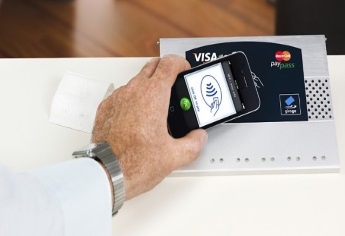Guide to Near Field Communication
Year after year the number of consumers using mobile devices to conduct both personal and commercial business transactions is growing. The smartphone has changed the way people conduct their day-to-day lives. One of the latest technologies to be added to the list of mobile device tools designed to make life easier is mobile wallets. Being able to pay for purchases with a smartphone is growing in popularity, with the mobile payment volume being estimated as high as $500 billion by 2020. In order for businesses to compete effectively it is important that they have at least a basic understanding of how mobile wallet systems work.

What is Near Field Communication and how does it work?
NFC is the technology that allows a mobile device such as a smartphone to communicate wirelessly using radio waves with the likes of a point-of-sale (POS) terminal when within close proximity to each other. This same technology is what allows contactless payments to be transacted. NFC uses radio-frequency identification (RFID). Although mobile payments is something fairly new, the use of RFID has been around for quite some time, in the form of grocery checkout scanners and baggage scanners at airports. RFID is also used in the tagging of cattle.
While NFC has been around since the early 2000’s many consumers see it as new technology. NFC has been used for access cards in office buildings, private garages and hotel rooms since its introduction. Today NFC is extending its usage to generating contactless payments.
Near Field Communication (NFC) requires that the user of the smartphone or other mobile device hold the device within an inch or two from the mobile payment reader in order for the transaction to process. Encrypted information is passed from one device to the other, and once the smartphone and reader communicate with each other a transaction can be executed within just a few seconds, making it extremely quick, easy and virtually painless. In this way customers can make purchases in far less time than if they manually swipe a credit or debit card, or use cash to pay.
Examples of NFC mobile payment systems
ApplePay, Samsung Pay and Android Pay are all mobile payment systems, and all three are intending to make their mobile payment apps standard features on all future new smartphone releases. These three mobile payment systems are some of the most widely recognized mobile wallets available. There are a growing number of mobile payments systems available today as businesses see the benefits they provide their customers.
How does a business accept NFC and how expensive is the equipment?
In order for a business to be able to accept contactless payments they will need to purchase and install a NFC-enabled payments reader. Prices for the readers vary widely, with some costing several hundred dollars and others being as low as $49.
Concerns about security
NFC mobile payments use the latest in dynamic encryption to ensure the highest level of security, thereby making them one of the safest ways to pay. In fact, NFC mobile payments systems are more secure than magnetic-stripe cards such as seen on most bank and credit cards. In order to use NFC mobile payments the user photographs their credit card into the smartphone, the details are then transmitted to the issuing bank. Your bank details are then replaced with a series of randomly generated numbers and transmitted back to the user’s smartphone and programmed in. This series of random numbers is useless to anyone trying to fraudulently gain access to the user’s credit card details.
As an additional security measure, the likes of ApplePay require a fingerprint in order to unlock their latest iPhones. If the iPhone is lost or stolen the person in possession of the device is unable to unlock it, therefore cannot access any information on the smartphone itself.
With ApplePay, Android Pay and Samsung Pay all making mobile payments a standard feature of their new smartphones the likelihood that more people will use mobile payments is strong. Young consumers are usually eager to adopt new technology as it is released, having few concerns about security; however older consumers may continue to be wary of possible security vulnerability. As NFC mobile payments evolve the number of people opting to use their smartphones to pay for purchases is set to increase significantly over the next 2 to 3 years. NFC mobile payments is easy for users to set up and once it is programmed in there is no need to pull out a physical credit card to make a purchase or make a payment again. The application of this technology is virtually limitless. As long as there is a mobile payments reader available, and the user has their credit card details programmed in, they can use their smartphone to make purchases or payments within seconds.


Mobile Payment Technology Provides Consumers with New Ways to Pay